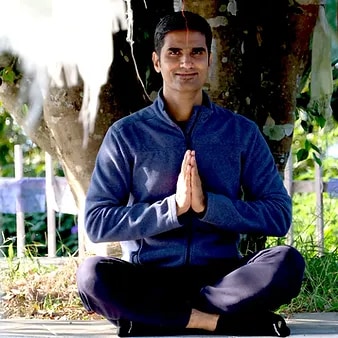Yoga Nidra Script
by Hardik Mehta

Introduction to Yoga Nidra
Yoga Nidra is a guided meditation and relaxation technique that originated from ancient yoga practices. It’s often referred to as “yogic sleep” because it induces a state of deep relaxation while maintaining full consciousness.
During a Yoga Nidra session, practitioners lie down in a comfortable position and follow the instructions of a trained instructor. The practice typically involves a systematic body scan, focusing on different parts of the body while consciously relaxing them. Participants may also engage in visualization exercises, breath awareness, and mental journeys to promote relaxation and inner awareness.
The goal of Yoga Nidra is to reach a state of profound relaxation where the body and mind can rejuvenate and heal. It’s believed to offer numerous benefits, including stress reduction, improved sleep, enhanced creativity, and a deeper connection with oneself.
Record this script as a voice memo on your smartphone, so you have it handy whenever you need to unwind and relax your body and mind. Talk in a calm, relaxing voice, and read the script very slowly. The headings do not need to be said out loud.
(You can also listen to the YouTube video by Sayujya Yoga for 20 minutes Guided Yoga Nidra)
Yoga Nidra Script
Welcome to your yoga Nidra practice, a deeply relaxing meditation experience designed to help you let go of distractions and connect with your inner self. Find a comfortable position lying on your back, with your palms facing up and your feet gently falling to the sides. Adjust your head and neck to a neutral position, ensuring your forehead is level or slightly elevated compared to your chin. Feel free to use a blanket under your head or a bolster under your knees for added comfort.
Close your eyes softly and allow your body to settle into relaxation. Find stillness and try to remain motionless throughout the practice. If you feel any discomfort, observe it first. If it persists, make necessary adjustments and return to stillness promptly.
Take a deep breath in, exhaling all worries and distracting thoughts. Allow your mind to completely relax, following the soothing rhythm of your breath. Notice the sounds around you without being disturbed by them. Feel the entirety of your body from head to toe, repeating the mantra “o-o-m-m” mentally, fostering stillness and awareness throughout. Now the practice begins.
Sankalpa
Now, affirm your sankalpa, a concise vow or affirmation stated in the present tense. Repeat it three times with sincerity and faith. If you don’t have one yet, simply affirm, “I am open to learning more about my deepest self.”
Rotation of Consciousness
Next, we’ll embark on a rotation of consciousness journey. Swiftly transfer your awareness to different parts of your body while remaining still. Visualize each part without actually moving it.
Begin with your right hand, moving through each finger, palm, wrist, and so on. Then, shift to your left hand, repeating the process. Continue with the back and front of your body, moving from head to toe and back again, experiencing each part fully in your mind.
Breath Awareness
Now, focus on your breath. Feel the rise and fall of your chest, ribs, and abdomen with each breath, sensing the nourishing energy flowing through you. Visualize your breath rising from your navel to your throat, like a gentle wave.
Listen to the soft sound of your breath, resembling the mantra “so-hum.” Inhale the “so” sound, exhale the “hum” sound, feeling the breath flow effortlessly.
Count your breaths from 10 to 1, inhaling as you count up and exhaling as you count down. Maintain awareness and restart counting if you lose track.
Awareness of Sensations & Visualisation
Now, awaken sensations in your body. Feel the heat of a scorching day, then the chill of snow, followed by the wetness of rain, and finally, the dryness of a desert. Allow each sensation to fade away.Concentrate on the space in front of your closed eyes, noticing any colors, patterns, or light. Visualize your mind screen, observing without attachment.
Immerse yourself in a visualization journey, imagining a beach scene and playful moments from your childhood. Feel the joy and freedom wash over you.
Return to your sankalpa, reaffirming it with conviction.
Finally, slowly bring your awareness back to your breath and physical relaxation. Notice your body resting on the floor and the sounds around you. Begin to gently move and stretch, eventually opening your eyes.
Take a moment on your right side, then return to a seated position. Your Yoga Nidra practice is complete.
Sayujya Yoga stands out as one of the best yoga institute in Mumbai, offering a comprehensive 200-hours Teacher Training Course that encompasses a wide range of topics, including Yoga Nidra and Cyclic Meditation. Renowned for its excellence, Sayujya Yoga delivers the best Ashtanga Yoga and Vinyasa courses in Mumbai. With a commitment to holistic wellness and authentic teaching, the institute provides a nurturing environment for students to deepen their practice and embark on a transformative journey. Sayujya Yoga’s dedication to quality instruction and traditional yoga principles ensures that students receive the highest standard of training, preparing them to become skilled and compassionate yoga teachers.
About the Author

Hardik Mehta
Hardik is an E-RYT 500 & YACEP (Yoga Alliance Continuing Education Provider), Yoga Alliance, USA. He has been practicing yoga for the last 9 years. Prior to finding his true calling in Yoga, he was working with various corporates for 12 years in the Retail and eCommerce sector.
